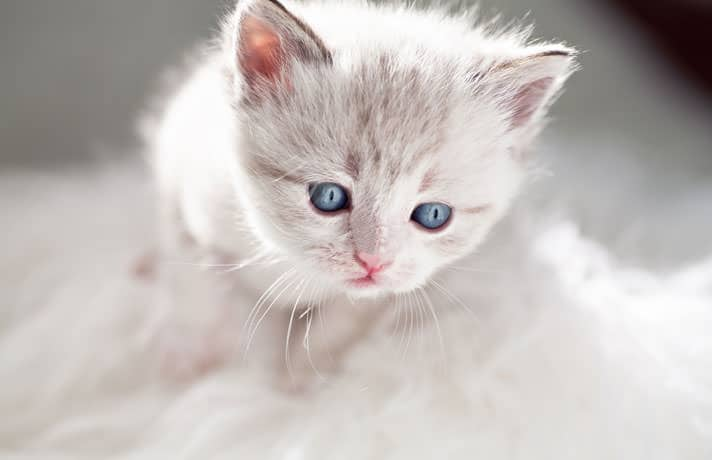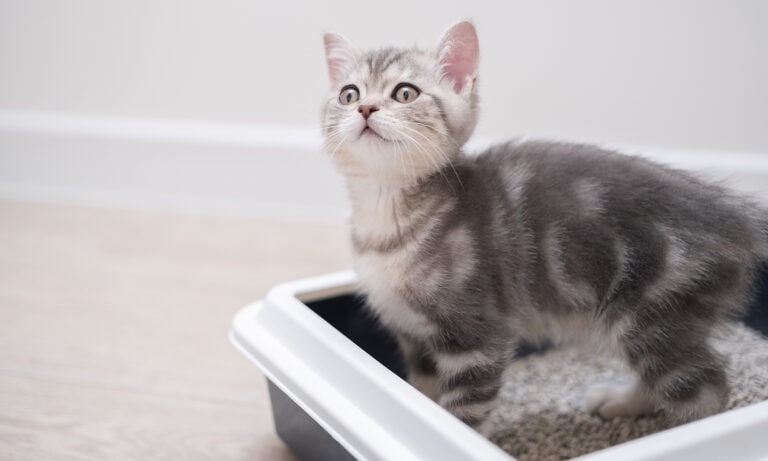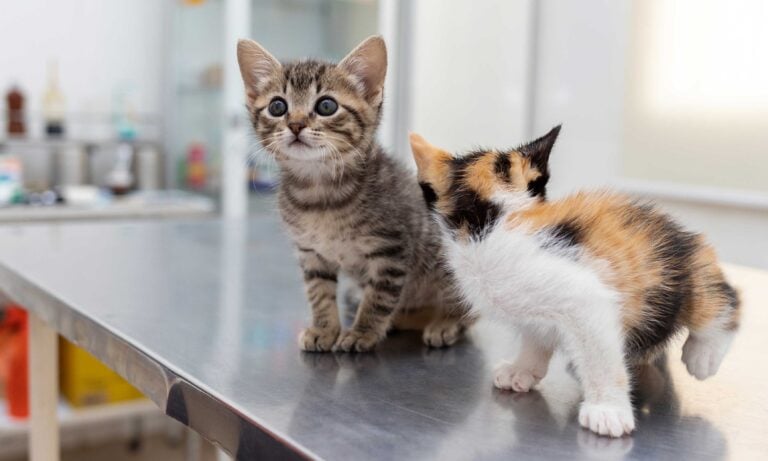If you’ve ever seen newborn kittens, you’ll notice they all start out with their eyes sealed shut. This is a natural protection designed to prevent infection and eye damage during birth.
During the kitten’s first weeks of life — anywhere from 2 to 16 days old — you’ll start to see her eyes open. Each kitten, even in the same litter, will open her eyes at different times, and sometimes an individual kitten’s eyes will open days apart from each other.
Once your kitten’s eyes are open, her vision still is developing, so she might not see clearly yet. During this time, kittens depend on smell, touch and their mother.
By about 3 weeks old, your kitten’s eyes should be opened completely. Her vision will continue to develop over the next several months, and according to Tony Johnson, DVM, (critical care specialist) in Carmel, Indiana, if the kitten’s eyes are clear and not red, pink or containing discharge, they should be fine.
Beautiful Blue Eyes
Most kittens, when their eyes open at about 2 weeks old, have light blue eyes, and Johnson said that over the next month or two the eye color changes to the color it will be throughout her adult life.
Most adult cats’ eyes are somewhere on the color continuum from green to yellow to orange to copper. And some breeds, like Siamese or Tonkinese, have blue eyes. You might also hear blue-green, hazel, gold and amber as descriptions of cats’ eye colors. My cats’ eyes have run the gamut, and my favorites were Jack’s beautiful blue eyes and Tripper’s intense amber eyes.
As a kitten’s eyes change from blue to her mature eye color, you might see flecks of all the different colors. These color flecks come from the pigment cells, also called melanocytes, in the eye’s iris and, as with humans, genetics dictate the final colors.
The two layers in the iris that determine eye color are the stroma and the epithelium, and the pigmented cells are found throughout both layers. The stroma is the outer layer and has loosely arranged pigment cells. Beneath the stroma is the epithelium, which has tightly packed pigment cells.
Both contribute to the pigment, but in different amounts. A lot of pigment creates orange or gold eyes; less pigment ends up green and no pigment in both layers turns out blue. Beyond genetics, neither coat color nor gender affect a kitten’s eye color, Johnson said.
Some cat breeds, such as Siamese, will keep their blue eyes into adulthood, and it’s perfectly fine if your kitten’s eyes do not change color.
“If the eyes appear shiny and healthy, and the cats can see, then it just happens that the eye color was blue,” Johnson says, adding that eyesight usually is mature around the same time as full weaning — by about 8 weeks old.
Most cat breeds, however, experience a gradual eye color change those first three months to their final color. And it can take up to a year for a kitten’s eyes to finish changing and darkening to her mature eye color and hue.
In some cases, cats end up with two differently colored eyes, such as one blue and one yellow, orange, brown or green. This is called complete heterochromia or, more commonly, odd-eyed. While any type of cat can develop odd eyes, it mostly occurs in solid or mostly white cats, such as Turkish Angora, Turkish Van and Japanese Bobtail.
“As long as there’s no discharge, the eyes are clear and the cat can see, you just have an unusual gene combination,” Johnson says. “If you’re worried, though, it’s always good to take them in to the vet for a look.”
You might have heard that blue-eyed or odd-eyed cats are prone to blindness; however, this is a misconception. But white cats can be more prone to hereditary deafness, and the concern increases if they also have one or both blue eyes. And interestingly, the deafness tends to occur in the ear on the same side as the blue eye.
Eye Color Changes Of Concern
Your cat’s eye color shouldn’t change again once mature. If you notice her eye color changing, it might indicate a health concern that needs medical attention.
“Sometimes there might be late bloomers,” Johnson says, “but most cases of adult color changes are from a medical issue going on with the eye.”
He added that it’s important for kitten owners to be able to differentiate between color in the iris and the cornea to spot medical problems early.
“The iris is the colored part around the pupil, and the cornea is the clear part in the front of the eye you actually see through,” Johnson says. “A blue iris is normal, and a blue cornea is abnormal. A wicked eye infection can make the cornea look blue, so if that happens, take the kitten to the vet for medical attention.”
In general, a cat or kitten’s eyes should be bright and clear. Signs of an eye infection or scratched eye, such as from play, are swelling, discharge, cloudiness, excessive blinking, visible third eyelid or nictitating membrane, crust in the corners of the eyes, squinting, tearing or watery eyes and squinting.
The most common eye issue in cats and kittens, Johnson said, is conjunctivitis, a highly contagious eye infection. For this infection, the most obvious symptom is runny eyes. The kitten might also squint and have dark tear stains on her fur. Thankfully, it’s easy to cure with prompt treatment.
Another relatively common eye infection in kittens is uveitis. For a quick eye anatomy lesson, the uvea is the part of the eye that includes the iris, the ciliary body (behind the iris) and the choroid (the middle of the eyeball containing the blood vessels). When one or more of these parts get inflamed, it’s called uveitis.
Symptoms of uveitis might include eye redness, discharge from the eyes, cloudiness and a change in eye color. When caught early, this too is easily treated.
Any time you suspect a problem or notice a change in your kitten’s eyes, play it safe and check in with your veterinarian. We definitely want our kittens to enjoy a long, healthy life.
By: Sandy Chebat
Featured Image: Via Zoonar/Val Thoermer/Zoonar/Thinkstock
Share:









